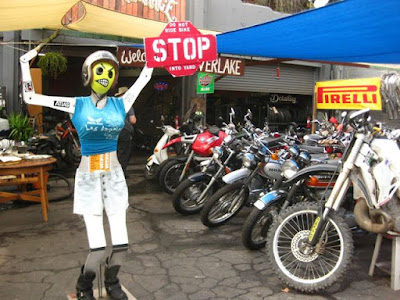It rained hard before it got light Monday morning. We had a walking tour through Silverlake planned with friends. J and my old neighborhood. Back in the 1970s. J was working downtown and I was going to school at USC so it seemed like a reasonable location.
It wasn't cool back then. Just a funky neighborhood.
 As I was preparing breakfast, I noticed a car out front of my mom's house. I went out to take in the garbage can and saw that it wasn't a car. It was traffic. This quiet, out of the way street has become a way to beat traffic. It's insane. But it's only for a short time in the morning. Maybe 20 minutes. But it's sick that there is so much traffic that cars are backed up the block on this out of the way residential street.
As I was preparing breakfast, I noticed a car out front of my mom's house. I went out to take in the garbage can and saw that it wasn't a car. It was traffic. This quiet, out of the way street has become a way to beat traffic. It's insane. But it's only for a short time in the morning. Maybe 20 minutes. But it's sick that there is so much traffic that cars are backed up the block on this out of the way residential street. There was a fair amount of nostalgia as we walked up and down the hills of streets roamed in our 20s, newly married, and discovering interesting people and places every time we went out.
In a lot of ways, the neighborhood looks remarkably the same. While in my mom's neighborhood contractors buy old little houses, tear them down, then build lot squeezing villas, there was very little of that on the streets we wandered. Places had new paint, maybe even a new facade, but most looked like the original buildings we'd wandered past over 40 years ago.
And this neighborhood is as likely to have lost parrot posters as lost dog posters.
The biggest difference I noticed was security. Rambling hillside apartment buildings that had interesting steps used to be open to the world. Now, many of them have security gates and locks. Our building's old inviting opening onto a courtyard with a view, now had a glassed in wall with a door. Fortunately a tenant came in and let us in so we could look around. But here's an examples of what I'm talking about.
So many places now have iron gates.
But the neighborhood's funkiness is alive and well. Here's a fence with little arm chairs and signs on it. Since this is a nostalgia trip, I've taken the liberty to play around with a few of the photos below in photoshop. In this case it was to get some closer views of the chairs along with the larger picture of the fence. But then I played with the color of the sky and the saturation.
And we walked down the Micheltorena stairs.
We stopped at Night Market Song - a Thai place that left my mouth with a satisfying, if low watt, glow - and wandered on Sunset past this motorcycle shop where our friend fell in love with an old used Vespa.
Much to my amazement, the Free Clinic was still there. As part of a graduate class, I volunteered as an intake worker there several nights a week for a semester.
It looked a bit tired, so I took some liberties again in photoshop to perk it up a bit.
After a couple of hours of exploring the old stomping grounds, we got back to the car and made one last stop at Barnsdale Park where I took this view of Hollywood from outside the Frank Lloyd Wright designed Hollyhock House.
I've got lots more thoughts, but no more time. It was good to just go out and have fun for the day after lots of paper shredding, sorting of boxes, and looking through old documents and memorabilia that give a little back story of my family that I never quite understood. If I have time . . .






















